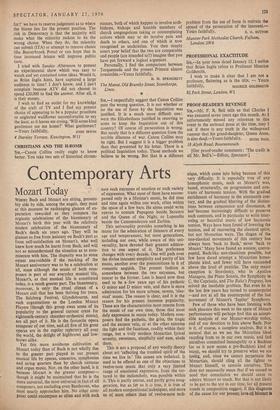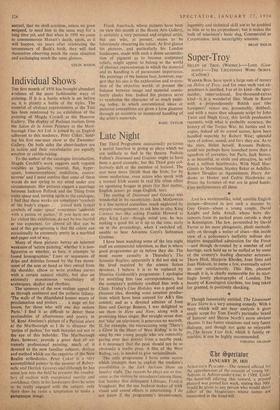Contemporary Arts
Mozart Today
WHERE Bach and Mozart are sitting, presum- bly side by side, among the angels, they must at this moment be exchanging glances of ex- pectation rewarded as they compare the orgiastic celebrations of the bicentenary of Mozart's birth this year with the relatively modest celebration of the bicentenary of Bach's death six years ago. They will be glances as free from jealousy on Bach's part as from self-satisfaction on Mozart's, who well knew how much he learnt from Bach, and will not so misunderstand the situation as to com- miserate with him. The disparity was to some extent unavoidable if the marking of the Mozart anniversary was to be a celebration at all, since although the music of both com- posers is part of our everyday musical life, Mozart's, as that musical life is constituted today, is a much greater part. The bicentenary, moreover, is only the ritual climax of a Mozart cult that has been thriving for years. The Salzburg Festival, Glyndebourne, and such organisations as the London Mozart Players (though this group owes some of its Popularity to the general current craze for eighteenth-century chamber-orchestral music), are all part of it. He is the favourite opera composer of our time, and.all five of his great operas are in the regular repertory all over the world, the delight of highbrows and low- brows alike.
Yet this more assiduous cultivation of Mozart today than of Bach is not wholly due to the greater part played in our present musical life by operas, concertos, symphonies and string quartets than by church cantatas and organ music. Nor, on the other hand, is it because Mozart is the greater composer— though it might be maintained that he is the more universal, the most universal in fact of all composers, not excluding even Beethoven, who most nearly approaches him. No other com- poser cotild encompass so often and with such ease such extremes of emotion or such variety of expression. What most of them have encom- passed only in a lifetime's music, he did time and time again within one work, often within the space of a few bars. He alone could write operas to contain Papageno beside Sarastro and the Queen of the Night, or Leporello beside the Commendatore and Zerlina.
This universality provides something in his music for the admiration of listeners of every age and temperament, but most generations, including our own, while aware of this uni- versality, have devoted their greatest admira- tion to one aspect of it. The preference changes with every decade. One will gush over the divine innocent simplicity and purity of his music, another over the premonitions in it of romantic anguish. The present fashion is somewhere between the two extremes, but nearer to the former. Less is heard now than used to be a •few years ago of his pathetic G minor and D minor vein, and there is more admiration for his more urbane, serene, 'clas- sical' music. The reason is clear, and it is the reason for his present immense popularity. These are the characteristics most remote from the music of our own time, those that most defy expression in music today. Modern com- posers find the pathetic, the grim, the tragic and the earnest vein, or at the other extreme the light and the facetious, readily within their range, but a truly modern Mozartian lyrical serenity, sweetness, simplicity and ease, elude them.
This is not a proposal of any woolly theory about art 'reflecting the troubled spirit of the time we live in.' The causes are technical. It used to be offered as one of the objections to twelve-note music that only a very limited range of emotional expression, from the tor- tured to the melancholy, was• possible within it. This is partly untrue, and partly gross exag- geration, but as far as it is true, it is true of all modern compositional techniques, and more so of most others than of twelve-note tech-
nique, which came into being because of this very difficulty. It is especially true of any homophonic music, such as Mozart's was, based, structurally, on progressions and con- trasts of harmonic tension. With the gradual enrichment of harmony in the nineteenth cen- tury, and the gradual blurring of the distinc- tions between consonance and dissonance, it has become increasingly difficult to preserve such contrasts, and in particular to write inter- esting or beautiful music of low harmonic tension. Ways have been found of lowering the tension, and of recovering the classical spirit, but not Mozartian ways. The slogan of the neo-classical movements of this century has always been 'back to Bach,' never 'back to Mozart.' Many have found an austere, contra- puntal, Bach-like neo-classicism possible, but few have dared attempt a Mozartian homo- phonic kind, and fewer still have succeeded above the level of pastiche. The only major exception is Stravinsky, who in Apollon Musagete, the Piano Sonata, the Symphony in C, the Capriccio, and The Rake's Progress, has solved the insoluble problem. But even he in the last few years has turned to counterpoint —and not at all the counterpoint of the last movement of Mozart's 'Jupiter' Symphony.
Few of those who have been listening with such pleasure this week to the spate of Mozart performances will perhaps find this an accept- able analysis of our Mozart-worship today, and of our devotion to him above Bach. Nor is it, of course, a complete analysis. But it is natural that as we see the Mozartian ideal receding from us in our own music, and feel ourselves committed inescapably to a Bachian (or as it now seems a pre-Bachian) kind of music, we should try to preserve what we are losing, and, since we cannot perpetuate the Mozartian, should cling all the tighter to Mozart himself, to console ourselves, This does not necessarily mean that if we ceased to need that consolation we should cease to admire Mozart so much. But that is not likely to be put to the test in our time, for all present trends in composition suggest, if this diagnosis of the cause for our present lovo Mozart is correct, that we shall continue, unless we grow resigned, to need him in the same way for a long time yet, and that when in 1991 we come to commemorate Mozart's death, again, as it will happen, six years after celebrating the tercentenary of Bach's birth, they will find themselves observing much the same situation and exchanging much the same glances.
COLIN MASON











































 Previous page
Previous page